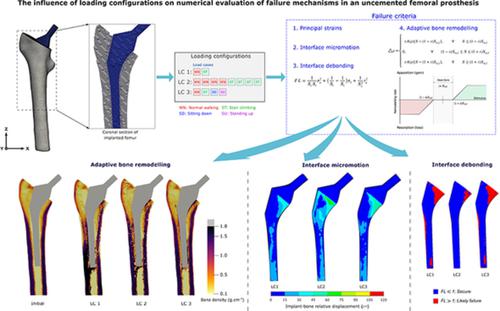当前位置:
X-MOL 学术
›
Int. J. Numer. Method. Biomed. Eng.
›
论文详情
Our official English website, www.x-mol.net, welcomes your feedback! (Note: you will need to create a separate account there.)
The influence of loading configurations on numerical evaluation of failure mechanisms in an uncemented femoral prosthesis.
International Journal for Numerical Methods in Biomedical Engineering ( IF 2.1 ) Pub Date : 2020-06-08 , DOI: 10.1002/cnm.3353 Basil Mathai 1 , Sanjay Gupta 1
International Journal for Numerical Methods in Biomedical Engineering ( IF 2.1 ) Pub Date : 2020-06-08 , DOI: 10.1002/cnm.3353 Basil Mathai 1 , Sanjay Gupta 1
Affiliation

|
The clinical relevance of numerical predictions of failure mechanisms in femoral prosthesis could be impaired due to simplification of musculoskeletal loading. This study investigated the extent to which loading configurations affect the preclinical analysis of an uncemented femoral implant. Patient‐specific, CT‐scan based FE models of intact and implanted femurs were developed and analysed using three loading configurations, which comprised of load cases representing daily activities. First loading configuration consisted of two load cases, each of walking and stair climbing. The second consisted of more number of load cases for each of these activities. The third included load cases of additional activities of standing up and sitting down. Failure criteria included maximum principal strains, interface debonding, implant‐bone relative displacement and adaptive bone remodelling. Simplified loading configurations led to a reduction (100‐1500 με) around cortical principal strains. The area prone to interface debonding were observed in the proximo‐medial part of implant and was maximum when all activities were considered. This area was reduced by 35%, when simplified loading configurations were chosen. Interfacial area of 88%‐96% experienced implant‐bone relative displacements below 40 μm; however maximum of 110 μm was observed at the calcar region. Lack of consideration of variety of activities overestimated (30%‐50%) bone resorption around the lateral part of the implant; hence, these bone remodelling results were less clinically relevant. Considering a variety daily activities along with an adequate number of load cases for each activity seemed necessary for pre‐clinical evaluations of reconstructed femur.
中文翻译:

载荷配置对非骨水泥股骨假体失效机制数值评估的影响。
由于肌肉骨骼负荷的简化,股骨假体失效机制的数值预测的临床相关性可能会受到损害。本研究调查了负载配置对非骨水泥股骨植入物临床前分析的影响程度。使用三种负载配置开发和分析了患者特定的、基于 CT 扫描的完整股骨和植入股骨的 FE 模型,其中包括代表日常活动的负载情况。第一种载荷配置由两个载荷工况组成,每个工况都是步行和爬楼梯。第二个包括每个活动的更多载荷工况。第三个包括站立和坐下额外活动的负载情况。失效标准包括最大主应变、界面脱粘、种植体-骨相对位移和适应性骨重塑。简化的加载配置导致皮质主应变周围的减少(100-1500 με)。在种植体的近中间部分观察到易于界面脱粘的区域,当考虑所有活动时,该区域最大。This area was reduced by 35%, when simplified loading configurations were chosen. 88%-96% 的界面区域经历了小于 40 μm 的种植体-骨相对位移;然而,在距距区域观察到最大值为 110 μm。缺乏对各种活动的考虑,高估(30%-50%)种植体外侧部分周围的骨吸收;因此,这些骨重建结果在临床上的相关性较低。
更新日期:2020-06-08
中文翻译:

载荷配置对非骨水泥股骨假体失效机制数值评估的影响。
由于肌肉骨骼负荷的简化,股骨假体失效机制的数值预测的临床相关性可能会受到损害。本研究调查了负载配置对非骨水泥股骨植入物临床前分析的影响程度。使用三种负载配置开发和分析了患者特定的、基于 CT 扫描的完整股骨和植入股骨的 FE 模型,其中包括代表日常活动的负载情况。第一种载荷配置由两个载荷工况组成,每个工况都是步行和爬楼梯。第二个包括每个活动的更多载荷工况。第三个包括站立和坐下额外活动的负载情况。失效标准包括最大主应变、界面脱粘、种植体-骨相对位移和适应性骨重塑。简化的加载配置导致皮质主应变周围的减少(100-1500 με)。在种植体的近中间部分观察到易于界面脱粘的区域,当考虑所有活动时,该区域最大。This area was reduced by 35%, when simplified loading configurations were chosen. 88%-96% 的界面区域经历了小于 40 μm 的种植体-骨相对位移;然而,在距距区域观察到最大值为 110 μm。缺乏对各种活动的考虑,高估(30%-50%)种植体外侧部分周围的骨吸收;因此,这些骨重建结果在临床上的相关性较低。



























 京公网安备 11010802027423号
京公网安备 11010802027423号